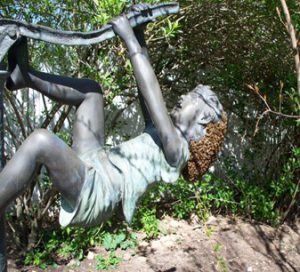Beekeeper helps remove swarm found on statue in Staten Island backyard
By Roger Guevara | rguevara@siadvance.com

Bees swarm statue on Oak Avenue, giving it a beehive hairdo. (Courtesy of Chester Crowl Jr.)
STATEN ISLAND, N.Y. — That’s some beehive hairdo!
Beekeeper Chester (Chet) Crowl Jr. was called to an Oakwood home on Saturday to remove a swarm of bees that had taken up residence on a statue of a little girl pumping water in the home’s backyard.
The exact spot? The statue’s head.
“The bees formed on the back of her head like a hairdo; it was unreal, I couldn’t believe it,” said Crowl of Chet Magical Bee Removal Service. “It was hysterical. I never in my life had anything like that, where they swarmed like that on a statue.”
While bee swarming season typically occurs in warmer months like May and June, this year’s season started in early-to-mid-April, Crowl said.
After spending two hours there, Crowl was able to remove the bees from the statue on Oak Avenue using a vacuum and box, which he made to keep the swarm together.
“I never in my life had anything like that, where they swarmed like that on a statue,” said Crowl.
ABOUT CHESTER CROWL JR.
A self-taught beekeeper, Crowl’s interest in the insects dates back to 1995 when he started working with bees. Today, he has a farm upstate where he has multiple beehives.
Over the years, Crowl has hosted talks about bees, helped the Staten Island Zoo, curated a bee exhibit at the Staten Island Children’s Museum, removed bees from the Conference House and Alice Austen House, and assisted the city Fire Department, borough president’s office and countless Staten Islanders with their bee infestations.
Crowl said he prefers to work at night to remove bees when there are fewer people around. “It’s the safest time for the public,” he said.
ABOUT BEE SWARMS
When bees swarm, they stay in a holding pattern temporarily while scout bees try to find a new home, Crowl said. When they do leave for their new digs, they become aggressive.
Bees typically swarm on a tree or a house; it’s all dependent on where the queen goes.
But it’s when they head toward someone’s residence that they need to be dealt with immediately, Crowl said.
“We need honeybees; they are vital to pollination… but in populated areas is not safe. Ten percent of people are allergic to bee stings,” he said. “We need them in the right areas.”
We are here to share current happenings in the bee industry. Bee Culture gathers and shares articles published by outside sources. For more information about this specific article, please visit the original publish source: https://www.silive.com/homegarden/2022/05/beekeeper-helps-remove-swarm-found-on-statue-in-staten-island-backyard.html








